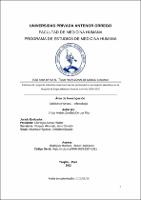| dc.contributor.advisor | Rodríguez Barboza, Héctor Uladismiro | |
| dc.contributor.author | Zavaleta De Los Ríos, Víctor Andrés | |
| dc.creator | Zavaleta De Los Ríos, Víctor Andrés | |
| dc.date.accessioned | 2022-08-05T00:36:09Z | |
| dc.date.available | 2022-08-05T00:36:09Z | |
| dc.date.issued | 2022 | |
| dc.identifier.uri | https://hdl.handle.net/20.500.12759/9255 | |
| dc.description.abstract | Identificar los factores de riesgo de infección cervicouterina por VPH
en mujeres atendidas en el Hospital de especialidades básicas La Noria.
Material y Métodos: Estudio observacional analítico de diseño “Casos y
Controles” sin emparejamiento con una relación caso-control de 1:2. El cual
incluyó a 168 mujeres distribuidas en 48 casos y 120 controles, atendidas en el
Hospital de Especialidades Básicas La Noria, durante el periodo 2019-2020, para
un calculó de OR para cada factor mediante análisis de contingencia en tablas
2xN.
Resultados: Entre las mujeres estudiadas se encontró asociación a infección
por VPH en poseer tres o más parejas a lo largo de la vida con un riesgo medido
de OR 2.23 (IC 95%: 1.11-4.50), de la misma forma, poseer parejas en el último
trimestre brinda un riesgo de OR 2.45 (IC 95%: 1.11-5.38), mientras que poseer
antecedente de ITS confiere OR 2.28(IC 95%: 1.04-5.02), por otra parte las
mujeres con educación superior tuvieron 74% menos riesgo con un OR 0.26(IC
95%: 0.09-0.72), y el uso de preservativo en el último trimestre confirió
protección de 64% con OR 0.46(IC 95%: 0.23-0-91).
Conclusión: Tener tres o más parejas sexuales a lo largo de la vida, tener
parejas sexuales en el último trimestre y poseer antecedentes de ITS son
factores de riesgo para infección cervicouterina por VPH, tener educación
superior y hacer uso de preservativos en el último trimestre son factores
protectores para infección por VPH. El 28.6% de mujeres participantes está
infectada por VPH, de las cuales 2 de cada 3 posee genotipos de alto riesgo para
cáncer de cuello uterino. | es_PE |
| dc.description.abstract | Identify the risk factors for cervicouterine infection by HPV in women
treated at the Basic Specialty Hospital La Noria.
Material and methods: Analytical observational study of ““Cases and Controls““
design without matching with a case-control ratio of 1:2. Which included 168
women distributed in 48 cases and 120 controls, treated at a Trujillo hospital
during the 2019-2020 period, for an OR calculated for each factor through
contingency analysis in 2xN tables.
Results: Among the women studied, association was found with HPV infection
in having three or more partners throughout life with a measured risk of OR 2.23
(95% CI: 1.11-4.50), in the same way, having partners in the last trimester
provides a risk of OR 2.45 (95% CI: 1.11-5.38), while having a history of STIs
confers OR 2.28 (95% CI: 1.04-5.02), on the other hand women with higher
education had 74% less risk with OR 0.26 (95% CI: 0.09-0.72), and condom use
in the last trimester conferred protection of 64% with OR 0.46 (95% CI: 0.23-0-
91).
Conclusion: Three or more sexual partners throughout life, sexual partners in
the last trimester and a history of STIs are risk factors for cervical HPV infection,
having higher education and using condoms in the last trimester are protective
factors for HPV infection. HPV. The 28.6% of participating women are infected
with HPV, of which 2 out of 3 have high-risk genotypes for cervical cancer. | en_US |
| dc.description.uri | Tesis | es_PE |
| dc.format | application/pdf | es_PE |
| dc.language.iso | spa | es_PE |
| dc.publisher | Universidad Privada Antenor Orrego | es_PE |
| dc.relation.ispartofseries | T_MED_3252 | |
| dc.rights | info:eu-repo/semantics/openAccess | es_PE |
| dc.rights.uri | https://creativecommons.org/licenses/by/4.0/ | es_PE |
| dc.source | Universidad Privada Antenor Orrego | es_PE |
| dc.source | Repositorio Institucional - UPAO | es_PE |
| dc.subject | Papilomas Humanos | es_PE |
| dc.subject | Cáncer Cervical | es_PE |
| dc.title | Factores de riesgo de infección cervicouterina por papilomavirus en mujeres atendidas en el Hospital de Especialidades Básicas La Noria 2019-2020 | es_PE |
| dc.type | info:eu-repo/semantics/bachelorThesis | es_PE |
| thesis.degree.level | Título Profesional | es_PE |
| thesis.degree.grantor | Universidad Privada Antenor Orrego. Facultad de Medicina Humana | es_PE |
| thesis.degree.name | Médico Cirujano | es_PE |
| thesis.degree.discipline | Medicina Humana | es_PE |
| dc.subject.ocde | https://purl.org/pe-repo/ocde/ford#3.02.27 | es_PE |
| renati.advisor.orcid | https://orcid.org/0000-0003-1557-2311 | es_PE |
| renati.author.dni | 70825918 | |
| renati.advisor.dni | 17986682 | |
| renati.type | https://purl.org/pe-repo/renati/type#tesis | es_PE |
| renati.level | https://purl.org/pe-repo/renati/level#tituloProfesional | es_PE |
| renati.discipline | 912016 | es_PE |
| renati.juror | Olortegui Acosta, Walter | |
| renati.juror | Vásquez Alvarado, Javier Ernesto | |
| renati.juror | Alcántara Figueroa, Christian Eduardo | |
| dc.publisher.country | PE | es_PE |


